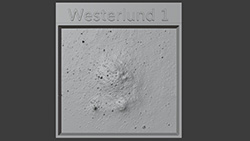CXC Home | Search | Help | Image Use Policy | Latest Images | Privacy | Accessibility | Glossary | Q&A
1
X-ray & Optical Images of Westerlund 1Credit: X-ray: NASA/CXC/INAF/M. Guarcello et al.; Optical: NASA/ESA/STScI; Image Processing: NASA/CXC/SAO/L. Frattare
These images of Westerlund 1, the biggest and closest “super” star cluster to Earth, features 12 days’ worth of Chandra observing time. The goal of this project is to help astronomers delve deeper into this galactic factory where stars are vigorously being produced. The X-rays detected by Chandra in the close-up and wide field images show young stars (mostly appearing as white and pink) as well as diffuse heated gas throughout the cluster (pink, green and blue, in order of increasing temperatures for the gas). An optical light image from Hubble is also included, where many of the stars appear as yellow and blue dots.
2
3D Printable Files: Westerlund 1(3D Print Credit: NASA/CXC/A. Jubett, using software by Tactile Universe/N. Bonne & C. Krawczyk & Blender)
This tactile plate of Westerlund 1 is a physical relief map based on the intensity of X-ray data, depicting a “super” star cluster. The relatively sparse canvas of space is peppered with raised dots of light of various sizes, representing stars in the cluster.
At the center of the plate is a diffuse cloud of gas encircling a grouping of tightly packed points. The shape and distribution of these stars in the cluster call to mind effervescent soda bubbles dancing above the ice cubes of a recently poured beverage.
At the center of the plate is a diffuse cloud of gas encircling a grouping of tightly packed points. The shape and distribution of these stars in the cluster call to mind effervescent soda bubbles dancing above the ice cubes of a recently poured beverage.
Return to: 'Super' Star Cluster Shines in New Look From NASA's Chandra (June 4, 2024)







